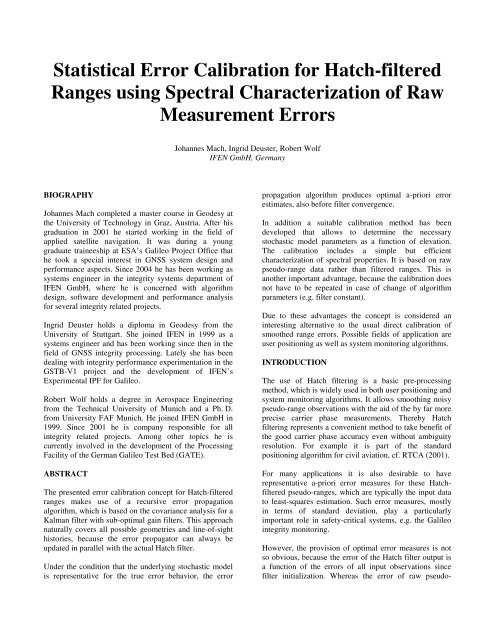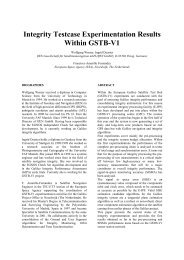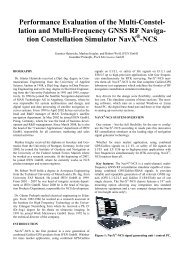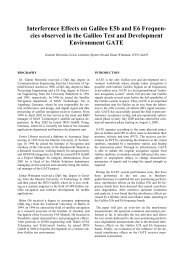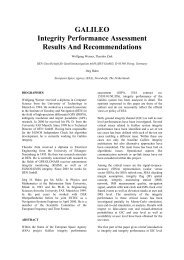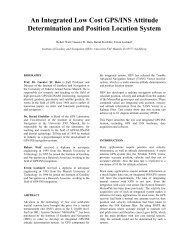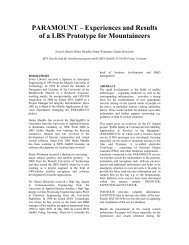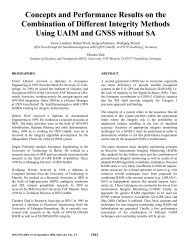Create successful ePaper yourself
Turn your PDF publications into a flip-book with our unique Google optimized e-Paper software.
Statistical Error Calibration for Hatch-filtered<br />
Ranges using Spectral Characterization of Raw<br />
Measurement Errors<br />
BIOGRAPHY<br />
Johannes Mach completed a master course in Geodesy at<br />
the University of Technology in Graz, Austria. After his<br />
graduation in 2001 he started working in the field of<br />
applied satellite navigation. It was during a young<br />
graduate traineeship at ESA’s Galileo Project Office that<br />
he took a special interest in GNSS system design and<br />
performance aspects. Since 2004 he has been working as<br />
systems engineer in the integrity systems department of<br />
<strong>IFEN</strong> GmbH, where he is concerned with algorithm<br />
design, software development and performance analysis<br />
for several integrity related projects.<br />
Ingrid Deuster holds a diploma in Geodesy from the<br />
University of Stuttgart. She joined <strong>IFEN</strong> in 1999 as a<br />
systems engineer and has been working since then in the<br />
field of GNSS integrity processing. Lately she has been<br />
dealing with integrity performance experimentation in the<br />
GSTB-V1 project and the development of <strong>IFEN</strong>’s<br />
Experimental IPF for Galileo.<br />
Robert Wolf holds a degree in Aerospace Engineering<br />
from the Technical University of Munich and a Ph. D.<br />
from University FAF Munich. He joined <strong>IFEN</strong> GmbH in<br />
1999. Since 2001 he is company responsible for all<br />
integrity related projects. Among other topics he is<br />
currently involved in the development of the Processing<br />
Facility of the German Galileo Test Bed (GATE).<br />
ABSTRACT<br />
The presented error calibration concept for Hatch-filtered<br />
ranges makes use of a recursive error propagation<br />
algorithm, which is based on the covariance analysis for a<br />
Kalman filter with sub-optimal gain filters. This approach<br />
naturally covers all possible geometries and line-of-sight<br />
histories, because the error propagator can always be<br />
updated in parallel with the actual Hatch filter.<br />
Under the condition that the underlying stochastic model<br />
is representative for the true error behavior, the error<br />
Johannes Mach, Ingrid Deuster, Robert Wolf<br />
<strong>IFEN</strong> GmbH, Germany<br />
propagation algorithm produces optimal a-priori error<br />
estimates, also before filter convergence.<br />
In addition a suitable calibration method has been<br />
developed that allows to determine the necessary<br />
stochastic model parameters as a function of elevation.<br />
The calibration includes a simple but efficient<br />
characterization of spectral properties. It is based on raw<br />
pseudo-range data rather than filtered ranges. This is<br />
another important advantage, because the calibration does<br />
not have to be repeated in case of change of algorithm<br />
parameters (e.g. filter constant).<br />
Due to these advantages the concept is considered an<br />
interesting alternative to the usual direct calibration of<br />
smoothed range errors. Possible fields of application are<br />
user positioning as well as system monitoring algorithms.<br />
INTRODUCTION<br />
The use of Hatch filtering is a basic pre-processing<br />
method, which is widely used in both user positioning and<br />
system monitoring algorithms. It allows smoothing noisy<br />
pseudo-range observations with the aid of the by far more<br />
precise carrier phase measurements. Thereby Hatch<br />
filtering represents a convenient method to take benefit of<br />
the good carrier phase accuracy even without ambiguity<br />
resolution. For example it is part of the standard<br />
positioning algorithm for civil aviation, cf. RTCA (2001).<br />
For many applications it is also desirable to have<br />
representative a-priori error measures for these Hatchfiltered<br />
pseudo-ranges, which are typically the input data<br />
to least-squares estimation. Such error measures, mostly<br />
in terms of standard deviation, play a particularly<br />
important role in safety-critical systems, e.g. the Galileo<br />
integrity monitoring.<br />
However, the provision of optimal error measures is not<br />
so obvious, because the error of the Hatch filter output is<br />
a function of the errors of all input observations since<br />
filter initialization. Whereas the error of raw pseudo-
anges can usually be calibrated as an elevationdependent<br />
function, the error of a smoothed range<br />
depends on the entire history of the given line-of-sight,<br />
including previous elevation angles, the filter time (time<br />
elapsed since filter initialization) and data gaps.<br />
This characteristic property of the Hatch filter makes<br />
“direct calibration” of smoothed ranges quite difficult,<br />
because in principle statistical calibration tables have to<br />
be established with respect to both elevation and filter<br />
time. However this requires an even larger amount of<br />
archived data and the results are still not accurate, because<br />
this approach does not account for data gaps and the exact<br />
elevation history.<br />
Therefore calibration is usually performed only with<br />
respect to elevation and only for the smoothed range error<br />
after filter convergence. This approach is feasible but<br />
clearly not optimal, since lines-of-sight can be used only<br />
after filter convergence and the elevation dependence has<br />
to be conservative to cover all situations. For example, the<br />
calibration for a low elevation has to cover the case of an<br />
ascending satellite (even lower elevations in the past),<br />
whereas the accuracy of a descending line-of-sight<br />
(higher elevations in the past) might be significantly<br />
better.<br />
The algorithm proposed in this paper is able to overcome<br />
the mentioned drawbacks by means of individual<br />
covariance propagation for each line-of-sight, always in<br />
parallel with the corresponding smoothing filter. Unlike<br />
other concepts it is based on statistical calibration of raw<br />
(unfiltered) pseudo-range errors, including its spectral<br />
characterization in terms of auto-correlation.<br />
The following sections describe the new error propagation<br />
algorithm, a possible error model (still to be validated in<br />
more detail) and a suitable calibration method.<br />
THE COLOURED NOISE PROBLEM<br />
The standard Hatch filter is defined by the following<br />
recursive formula (cf. Hofmann-Wellenhof et al., 1998):<br />
R ˆ<br />
ˆ<br />
) + w<br />
w<br />
k = ( 1−<br />
wk<br />
)( Rk−<br />
1 + ϕ k −ϕ<br />
k−1<br />
k<br />
with<br />
⎧ 1/<br />
k<br />
= ⎨<br />
⎩1/<br />
T<br />
flt<br />
for k < T<br />
for k ≥ T<br />
Ri ˆ ...........smoothed pseudo-range (epoch i)<br />
R ...........raw pseudo-range (epoch i)<br />
i<br />
ϕ ............carrier phase (epoch i)<br />
i<br />
flt<br />
flt<br />
k<br />
R<br />
k<br />
w i ...........weight factor (epoch i)<br />
T ..........filter constant (e.g. 300 seconds)<br />
flt<br />
The above formula shows that at any epoch the smoothed<br />
range is a linear combination of the smoothed range of the<br />
previous epoch as well as “raw” pseudo-range and carrier<br />
phase observations. Therefore it appears possible to use<br />
simple standard covariance propagation for linear<br />
functions to propagate the variance. This would indeed be<br />
possible for “white” noise errors. However, pseudo-range<br />
errors usually are affected by time-correlated “coloured”<br />
noise, which is mainly caused by multi-path effects. As a<br />
consequence the new observation in general is correlated<br />
with the smoothed range of the previous epoch. This<br />
correlation somehow has to be taken into account,<br />
otherwise results will be wrong (usually optimistic).<br />
One option would be to use the explicit (non-recursive)<br />
expression of the smoothed range as linear function of<br />
raw observations only.<br />
∑ − k 1<br />
i=<br />
0<br />
Rˆ = w ( R + ϕ −ϕ<br />
k<br />
k,<br />
i<br />
k −i<br />
with ∏ − i<br />
w<br />
k,<br />
i<br />
= w<br />
1<br />
k−i<br />
j=<br />
0<br />
k<br />
( 1−<br />
w<br />
k −i<br />
k−<br />
j<br />
In that case one has only to deal with correlations between<br />
raw measurements, which can be derived from a model.<br />
Unfortunately the Hatch filter has an infinite impulse<br />
response, which means that the above sum can become<br />
very long (theoretically infinite), at least if exact<br />
computation is desired (without truncation). Due to the<br />
resulting large matrix multiplications this approach is<br />
very inconvenient and rather unsuitable for practical<br />
processing with many lines-of-sight.<br />
Therefore we are considering a recursive algorithm,<br />
which is presented in the following section. As explained<br />
above, for a recursive algorithm it is always necessary to<br />
model the correlation between raw observations and<br />
smoothed ones, and this is what represents the main<br />
difficulty in this context.<br />
ERROR PROPAGATION ALGORITHM<br />
Kalman-like formulation of Hatch filter<br />
The Hatch filter output is computed as a weighted average<br />
of the smoothed pseudo-range of the previous epoch,<br />
propagated to the current epoch using phase observations,<br />
and the current raw pseudo-range. This is equivalent to a<br />
Kalman filter recursion, with the important difference that<br />
the weight of the new observation is pre-determined and<br />
)<br />
)
not computed from a stochastic model. In fact, the<br />
following matrix notation of the Hatch filter<br />
⎡Rˆ<br />
⎤ ⎡ ˆ ⎤ ⎡ 1−<br />
⎤ ⎛<br />
⎜⎡<br />
⎤ ⎡1<br />
k R w<br />
−1<br />
k wk<br />
R<br />
k<br />
k<br />
⎢ ⎥ = ⎢ ⎥ + ⎢ ⎥ −<br />
⎜⎢<br />
⎥ ⎢<br />
⎣ ˆ ϕ ⎦ ⎣ ˆ −1⎦<br />
⎣ 0 1 ⎦ ⎝⎣ϕ<br />
k ⎦ ⎣0<br />
k ϕk<br />
0⎤<br />
⎡Rˆ<br />
⎤⎞<br />
k−1<br />
⎢ ⎥<br />
⎟<br />
1<br />
⎥<br />
⎦ ⎣ ˆ ϕ ⎦<br />
⎟<br />
k−1<br />
⎠<br />
exactly corresponds to the basic equations of a Kalman<br />
filter:<br />
pred<br />
pred<br />
Observation update: xˆ = xˆ<br />
+ K ( z − H xˆ<br />
)<br />
pred<br />
Time update: x ˆ = Φ ˆ<br />
k<br />
k xk<br />
−1<br />
k<br />
The corresponding gain (K), observation (H) and<br />
transition (Φ) matrices can be easily formed by<br />
comparison of the above recursions.<br />
Simplified formulation<br />
Alternatively one can also use a simplified Kalman-like<br />
formulation of the Hatch filter with a one-element state<br />
vector representing the smoothed range.<br />
pred<br />
pred<br />
Observation update: Rˆ<br />
= Rˆ<br />
+ w ( R − Rˆ<br />
)<br />
k<br />
Time update: ˆ pred<br />
R Rˆ<br />
+ ( ϕ −ϕ<br />
)<br />
k<br />
k<br />
k<br />
k<br />
k<br />
= k−1<br />
k k−1<br />
The carrier phase is regarded here as deterministic<br />
parameter and is used only for prediction of the next<br />
epoch. This formulation of course neglects the carrier<br />
phase error, which indeed can be regarded as minor with<br />
respect to the pseudo-range error.<br />
State-vector augmentation<br />
The above models (exact and simplified) still do not allow<br />
covariance propagation in case of colored observation<br />
noise, because the Kalman formulas are based on the<br />
assumption that the observation vector and the state<br />
vector are uncorrelated. As already explained in the<br />
previous section, this is generally not the case for the<br />
Hatch filter in presence of time-correlated pseudo-range<br />
errors.<br />
Fortunately this problem can be overcome by the wellknown<br />
technique of state-vector augmentation. The timecorrelated<br />
part of the observation error (εCN) is simply<br />
shifted from the observation to the parameter side of the<br />
observation equation, where it is modeled by means of<br />
one or several additional state-vector parameters.<br />
k<br />
k<br />
k<br />
k<br />
k<br />
R<br />
R + c<br />
CN<br />
= ε CN + WN<br />
= ε<br />
WN<br />
Thereby only the white noise part (εWN) remains on the<br />
right hand side of the equation, which is obviously not<br />
correlated with any of the state vector parameters.<br />
Note that the algorithm can easily be adapted to any<br />
stochastic model. For the present study it was decided to<br />
consider a 1 st order Gauss-Markov (GM) process, which<br />
can be modeled with only one additional state-vector<br />
element. The GM process is completely defined by two<br />
parameters<br />
σ GM .......standard deviation of GM process<br />
T ..........correlation time of GM process<br />
flt<br />
and is generated from a Gaussian white noise process<br />
with unit standard deviation (denoted by n i ) by the<br />
following recursion:<br />
x0 = σ GM<br />
x<br />
k<br />
= e<br />
n<br />
0<br />
x<br />
+ σ<br />
−β<br />
( tk<br />
−tk<br />
)<br />
( − e ) nk<br />
−β<br />
( tk<br />
−tk<br />
−1)<br />
−1<br />
k−1<br />
GM 1<br />
The parameter β is the reciprocal of the correlation time.<br />
β = 1 T flt<br />
It is convenient to use a unit GM process (with standard<br />
deviation one) in the state-vector and to scale it to the<br />
needed standard deviation, which can change with respect<br />
to time and in this context typically is a function of the<br />
elevation angle. Thus the observation equation takes on<br />
the following form:<br />
R σ = ε<br />
+ GM ( ε ) xGM<br />
, unit<br />
WN<br />
The observation model is equivalently expressed by the<br />
observation matrix (H) and observation covariance<br />
matrix (R):<br />
k<br />
= [ 1 GM ] R 2<br />
k = [ σ WN ]<br />
H σ<br />
The dynamic and stochastic models are defined by the<br />
transition matrix (Φ) and process noise matrix (Q):<br />
Φ<br />
k<br />
⎡1<br />
= ⎢<br />
⎣0<br />
e β<br />
0<br />
− )<br />
( tk<br />
−tk<br />
−1<br />
⎤<br />
⎥<br />
⎦
⎡0<br />
0<br />
Qk =<br />
⎢<br />
β (<br />
⎣0<br />
1 − e<br />
− 2 tk<br />
−tk<br />
−1)<br />
⎤<br />
⎥<br />
⎦<br />
The decisive point is that not the optimal Kalman gain<br />
matrix is used, but instead the gain factor of the range<br />
parameter is set to the weight used by the Hatch filter and<br />
the gain factor associated with the GM parameter is set to<br />
zero.<br />
K<br />
k<br />
⎡wk<br />
⎤<br />
= ⎢ ⎥<br />
⎣ 0 ⎦<br />
This means that the GM parameter is a pure nuisance<br />
parameter, which is not estimated. Nevertheless it<br />
influences the state vector covariance matrix through the<br />
observation equation.<br />
The observation update of the covariance matrix can be<br />
performed by means of the Kalman filter equation for<br />
“sub-optimal” gain factors (cf. Brown, 1997):<br />
k<br />
pred<br />
T<br />
T<br />
( I − K H ) P ( I − K H ) K R K<br />
P =<br />
+<br />
k<br />
k<br />
k<br />
Finally, the time update is computed using the familiar<br />
propagation formula:<br />
pred<br />
k = Φk<br />
k−1<br />
T<br />
k<br />
P P Φ + Q<br />
k<br />
This completes the necessary set of formulas. The<br />
recursion is performed in parallel to the Hatch filter.<br />
Whenever a pseudo-range is fed into the Hatch filter, the<br />
covariance matrix is first propagated to the current epoch<br />
(time update) and subsequently updated with the same<br />
gain factor as the Hatch filter (observation update). In this<br />
way the covariance matrix always represents the current<br />
state of the Hatch filter.<br />
STOCHASTIC MODEL<br />
This section briefly describes a simple but effective<br />
stochastic error model, which is proposed for usage in<br />
combination with the algorithm presented above. It is a<br />
three-component model consisting of:<br />
• A white noise component (characterized by σWN)<br />
• A Gauss-Markov component (σGM, Tflt)<br />
• An additional noise floor (σNF)<br />
While the white noise refers to the errors due to receiver<br />
noise and interference, the colored noise (GM) refers to<br />
slowly varying errors e.g. caused by multipath. The<br />
“noise floor” component stands for an additional error,<br />
k<br />
k<br />
k<br />
k<br />
k<br />
which is constant or has so strong time-correlation that it<br />
cannot be eliminated by any filtering.<br />
The noise floor parameter looks somewhat artificial but is<br />
nevertheless useful. It represents a lower bound for the<br />
error of the smoothed ranges. Furthermore it can also be<br />
used to account for the carrier phase error, which is<br />
neglected by the simplified error propagation algorithm.<br />
The resulting auto-correlation function of the pseudorange<br />
error is shown in the figure below.<br />
2<br />
σ WN<br />
2<br />
σ GM<br />
2<br />
σ NF<br />
R<br />
2<br />
( τ ) = σ e<br />
−βτ<br />
RGM GM<br />
β = 1 Tflt<br />
Figure 1: Auto-correlation function for 3-component<br />
model<br />
The model is fully characterized by only 4 parameters,<br />
which are assumed to be a function of elevation. The<br />
necessary calibration of the model parameters is described<br />
in the next section.<br />
CALIBRATION OF MODEL PARAMETERS<br />
In principle all model parameters can be determined<br />
directly from the auto-correlation function, which<br />
represents the spectral behavior of the error (equivalently<br />
to the spectral power density function). For this purpose<br />
the auto-correlation function has to be empirically<br />
sampled for a suitable set of time differences τi.<br />
This can be done either by using the conventional autocorrelation<br />
formula<br />
∑ − N 1<br />
1<br />
N<br />
i=<br />
0<br />
i i )<br />
[ y(<br />
t ) y(<br />
t + ]<br />
R( τ ) =<br />
τ<br />
or alternatively via a “de-correlation” parameter, which<br />
can be estimated using a time difference operator.<br />
∑[ ]<br />
−1<br />
2<br />
2 − +<br />
= 0<br />
1 N<br />
N y(<br />
ti<br />
) y(<br />
ti<br />
)<br />
i<br />
2<br />
D( τ ) =<br />
τ<br />
R( τ ) = σ − D(<br />
τ )<br />
The theoretical equivalence of the two methods can be<br />
easily shown by the following derivation:<br />
τ
{ } 2<br />
= 2<br />
i i<br />
{ } 2<br />
2<br />
E y(<br />
ti<br />
) − 2y(<br />
ti<br />
) y(<br />
ti<br />
+ τ ) + y(<br />
t + τ<br />
2 { y(<br />
t ) } − E{<br />
y(<br />
t ) y(<br />
t + τ ) }<br />
1 D (τ ) E [ y(<br />
t ) − y(<br />
t + τ ) ]<br />
1 = 2<br />
i )<br />
E<br />
= i<br />
i i<br />
2<br />
= σ − R(<br />
τ )<br />
The advantage of the de-correlation is that for strongly<br />
correlated input signals it converges more quickly than<br />
the auto-correlation, because the time differences are<br />
much less correlated than the values themselves. On the<br />
other hand the calibration of the total variance (τ = 0)<br />
remains the same and still needs a lot of data in case of<br />
high auto-correlation.<br />
2<br />
σ total<br />
R<br />
D(τ)<br />
[ ] 2<br />
y(<br />
t)<br />
− y(<br />
1 D( τ ) = )<br />
2 ∑ t + τ<br />
N<br />
Figure 2: Reconstruction of auto-correlation function<br />
using statistical de-correlation<br />
What remains to be done is to fit the white noise and<br />
Gauss-Markov parameters to the statistically<br />
reconstructed auto-correlation curve. It is rather hard to<br />
estimate the noise floor value from the auto-correlation<br />
function, which has to be chosen based on analysis or<br />
assumptions. It should be at least as large as the phase<br />
noise standard deviation.<br />
To do the curve fitting the statistical auto-correlation is<br />
required only for a limited set of τ-values. (This is the<br />
main reason, why it is more efficient to work with the<br />
auto-correlation than with the power spectrum.) A<br />
possible choice of τ-values is<br />
τ =<br />
{ 0, 1, 2, 4, 8, 16, ... }<br />
It reflects the fact that the model auto-correlation changes<br />
more slowly for large τ-values than for small ones.<br />
An approximate estimate of the GM parameters can<br />
already be obtained by fitting a straight line to the autocorrelation<br />
values of just a few low τ-values. The<br />
approximate variance can be retrieved from the<br />
intersection of the fitted line with the y-axis, the<br />
correlation time from the inclination (see Figure 3). More<br />
exact values can be found by means of iterative<br />
τ<br />
estimation of the shape parameters of an exponential<br />
function.<br />
R<br />
2<br />
σ WN<br />
inclination ≈ σ GM 2 /τcorr<br />
Figure 3: Approximate determination of GM<br />
parameters by means of line fitting<br />
The calibration can be performed e.g. based on the codeminus-carrier<br />
(CmC) indicator. The CmC must be<br />
corrected for its arbitrary mean value, which can be<br />
determined for each uninterrupted tracking period of a<br />
given line-of-sight. Furthermore the CmC should be<br />
computed from the ionospheric-free code and phase<br />
combinations, as these are not affected by code-carrier<br />
divergence due to ionospheric refraction.<br />
Since the stochastic properties of pseudo-range errors are<br />
assumed to be a function of the elevation angles, the autocorrelation<br />
function has to be determined and analyzed for<br />
a set of elevation classes (bins). For the application in the<br />
error propagation algorithm the parameters can then be<br />
linearly interpolated between elevation bins.<br />
The following list summarizes the steps that are necessary<br />
for the calibration of e.g. a monitoring receiver:<br />
• Compute the ionospheric-free code and phase<br />
combination for a sufficiently large period of time<br />
(several days)<br />
• Compute the code-minus-carrier combination and<br />
correct it for the mean value per uninterrupted<br />
tracking period<br />
• Estimate statistically the total error variance (per<br />
elevation bin)<br />
• Estimate statistically the de-correlation parameter for<br />
a suitable set of τ-values (per elevation bin)<br />
• Reconstruct the auto-correlation function based on<br />
total variance and de-correlation estimates (per<br />
elevation bin)<br />
• Define a reasonable noise floor variance ( σ )<br />
2<br />
NF<br />
2<br />
• Estimate the Gauss-Markov parameters ( σ , β )<br />
τ<br />
using curve fitting and taking into account the noise<br />
floor variance (per elevation bin)<br />
GM
• Compute for each elevation bin the white noise<br />
variance ( σ ) according to the below formula<br />
2<br />
WN<br />
2<br />
WN<br />
σ = σ −σ<br />
−σ<br />
2<br />
total<br />
2<br />
GM<br />
SIMULATION EXAMPLES<br />
2<br />
NF<br />
The following two simple examples show that the error<br />
propagation algorithm yields valid results.<br />
Pure white noise case<br />
Input error: σ WN = 1, σ GM = σ NF = 0<br />
Hatch filter: T flt = 100<br />
Figure 4: Time series of standard deviation of<br />
smoothed ranges (pure white noise case)<br />
As shown by Figure 4 the computed standard deviation of<br />
the smoothed ranges indeed approaches the theoretical<br />
limit value (0.071) defined by the following equation:<br />
2 σ<br />
σ smo =<br />
2T<br />
2<br />
raw<br />
flt<br />
The plot further shows that the best smoothing<br />
performance is reached only after a period equal to 2-3<br />
times the filter constant.<br />
Pure Gauss-Markov case<br />
Input error: σ GM = 1, τ corr = 50 s<br />
Hatch filter: T flt = 100<br />
Figure 5: Time series of standard deviation of<br />
smoothed ranges (pure Gauss-Markov case)<br />
The resulting smoothing error standard deviation after<br />
filter convergence (see Figure 5) is again consistent with<br />
the theoretical limit value (0.577), which can be<br />
calculated using the following relation (based on Brown,<br />
1997):<br />
σ<br />
2<br />
smo<br />
= σ<br />
2<br />
raw<br />
τ<br />
τ + T<br />
flt<br />
The comparison of the two examples demonstrates very<br />
well the enormous impact of colored noise on the<br />
accuracy improvement that can be reached by Hatch<br />
filtering.<br />
CONCLUSIONS<br />
Summarizing, a complete concept for the error calibration<br />
of Hatch-filtered ranges has been developed, which is<br />
based on a recursive variance propagation algorithm and a<br />
suitable method for the calibration of the stochastic model<br />
parameters.<br />
The new approach is regarded as a very promising option<br />
for usage in user positioning algorithms and (integrity)<br />
monitoring systems.<br />
Test computations, which have been carried out with a<br />
software prototype, confirm the validity of the algorithm<br />
and the correctness of the theoretical analysis.<br />
The next step should be a detailed assessment of the<br />
adequacy of the proposed 3-component stochastic model.<br />
REFERENCES<br />
Brown, R.; Hwang, P. (1997); Introduction to Random<br />
Signals and Applied Kalman Filtering; John Wiley &<br />
Sons, 3 rd edition<br />
Hofmann-Wellenhof, B.; Lichtenegger, H.; Collins, J.<br />
(1998); GPS Theory and Practice; Springer-Verlag, 4 th<br />
edition<br />
RTCA (2001); Minimum Operational Performance<br />
Standards For Global Positioning System / Wide Area<br />
Augmentation System Airborne Equipment, RTCA<br />
Document No.: RTCA/DO-229C, RTCA Inc.,<br />
Washington D.C., 28 November 2001


